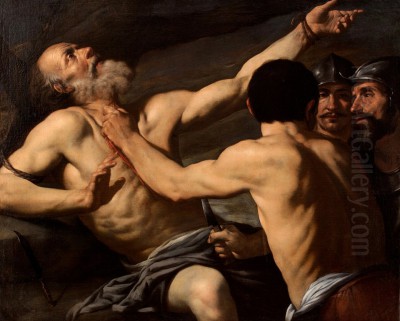
Andrea Vaccaro (1604-1670) stands as a significant, if sometimes underappreciated, figure in the vibrant artistic milieu of seventeenth-century Naples. A prolific painter, his career spanned several decades, witnessing and contributing to the evolution of the Neapolitan Baroque style. Born into a city that was a crucible of artistic innovation, Vaccaro navigated the powerful currents of Caravaggism, the elegance of Bolognese classicism, and the dynamic compositions of Flemish masters, forging a distinctive style that resonated with patrons both in Italy and abroad, particularly in Spain. His oeuvre, predominantly religious, is characterized by a sensitive handling of light and shadow, a profound psychological depth in his figures, and an ability to convey both dramatic intensity and tender piety.
Early Life and Artistic Formation in Naples
Andrea Vaccaro was born in Naples in 1604, into a family with artistic connections, which likely provided an early exposure to the world of painting. While details of his earliest training are somewhat scarce, it is documented that he initially pursued literary studies. This foundation in letters might have contributed to the narrative clarity and intellectual depth often found in his later works. However, the allure of the visual arts proved stronger, and he soon turned his attention to painting.
The artistic environment of Naples in the early 17th century was electrifying. The brief but impactful presence of Michelangelo Merisi da Caravaggio in the city (1606-1607 and 1609-1610) had left an indelible mark. Caravaggio's revolutionary naturalism, dramatic use of chiaroscuro (tenebrism), and emotionally charged depictions of religious scenes had captivated a generation of Neapolitan artists. Young painters were eager to emulate his style, leading to the flourishing of Caravaggism in Naples.
It is suggested that Vaccaro may have initially studied under Gerolamo Imparato, a painter working in a late Mannerist style. However, no surviving works definitively confirm this apprenticeship, and Imparato's influence on Vaccaro's mature style seems minimal compared to the overwhelming impact of Caravaggio and his followers. The true crucible of Vaccaro's early development was undoubtedly the pervasive influence of Caravaggism.
The Embrace of Caravaggism
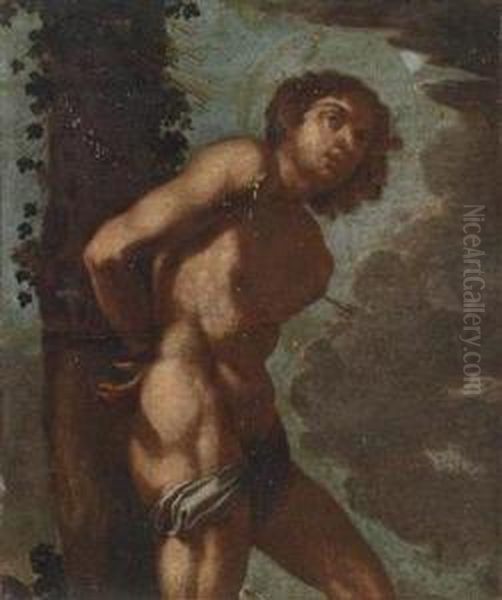
Around 1620, Andrea Vaccaro fully immersed himself in the Caravaggesque movement. This was a period of intense study and emulation. He, like many of his contemporaries such as Jusepe de Ribera (Lo Spagnoletto), Battistello Caracciolo, and Carlo Sellitto, was drawn to Caravaggio's directness, his use of ordinary people as models for sacred figures, and the palpable drama created by his stark lighting.
A testament to his early dedication to Caravaggio's style is his copy of Caravaggio's Flagellation of Christ. The original, painted for the Church of San Domenico Maggiore in Naples (and now at the Museo di Capodimonte), was a seminal work. Vaccaro's copy, also housed in San Domenico Maggiore, demonstrates his early mastery of tenebrism and his ability to capture the raw emotional power of the master. This practice of copying was common, serving not only as a learning tool but also to meet the demand for works in the popular Caravaggesque vein.
Vaccaro's early independent works from this period, such as David with the Head of Goliath (Florence, Fondazione Longhi) and his depictions of Saint Sebastian (one notable version in Naples, Museo di Capodimonte), clearly exhibit these Caravaggesque traits. These paintings are characterized by strong contrasts of light and dark, with figures emerging dramatically from shadowy backgrounds. The naturalistic rendering of anatomy and the intense psychological portrayal of the subjects are hallmarks of this phase. He focused on the human drama, the suffering, and the piety of his figures, making the sacred narratives relatable and deeply moving.
Evolution of Style: New Influences and a Softer Palette
While Caravaggism provided a powerful foundation for Vaccaro, his artistic journey did not end there. By the 1630s, a noticeable evolution began to occur in his style. Naples, a major European cultural hub, was open to diverse artistic currents. Vaccaro, a perceptive and adaptable artist, started to absorb new influences that tempered the starkness of his earlier Caravaggism.
A significant influence came from the Bolognese school, particularly the works of Guido Reni. Reni's classicizing elegance, his softer palette, idealized figures, and more graceful compositions offered an alternative to the raw intensity of Caravaggio. The works of other Bolognese masters like Domenichino and Guercino also contributed to this shift towards a more refined and less dramatic aesthetic that was gaining favor.
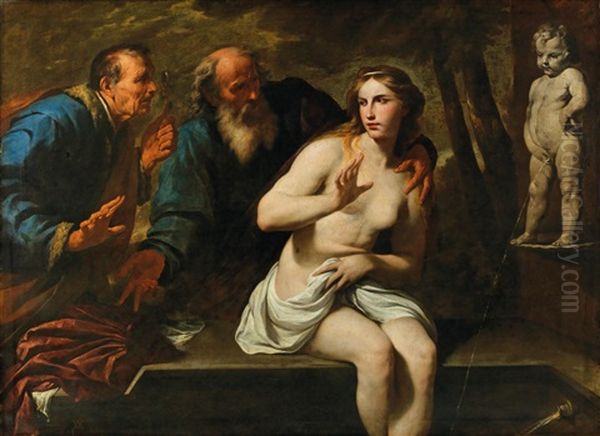
Furthermore, the influence of Flemish masters, notably Anthony van Dyck, who had worked in Italy, and Peter Paul Rubens, whose dynamic compositions and rich colors were widely known, began to filter into Neapolitan painting. Van Dyck's aristocratic elegance and psychological acuity, especially in portraiture, and Rubens's vibrant energy and complex figural arrangements, provided further avenues for stylistic development.
Pietro Novelli, a Sicilian painter who also worked in Naples and was influenced by Van Dyck, is another artist whose style shows parallels with Vaccaro's evolving approach. Both artists moved towards a more luminous and painterly technique.
This confluence of influences led Vaccaro to develop a more nuanced style. While he retained the strong modeling and emotional depth learned from Caravaggio, his use of chiaroscuro became less extreme. His palette brightened, his compositions became more balanced, and his figures often acquired a greater sense of grace and serenity. This synthesis resulted in a style that was both powerful and refined, appealing to a broad range of patrons. Works from this period demonstrate a sophisticated blend of naturalism with a more idealized and harmonious aesthetic.
Major Themes and Subject Matter
Andrea Vaccaro was primarily a painter of religious subjects, a reflection of the dominant patronage of the Church and religious orders during the Counter-Reformation. His repertoire included numerous depictions of scenes from the Old and New Testaments, lives of saints, and allegorical figures.
His depictions of the Madonna and Child were numerous and popular, often imbued with a tender intimacy. He frequently painted penitent saints, such as Mary Magdalene and Saint Peter, subjects that allowed for the exploration of profound human emotions like remorse, devotion, and spiritual longing. The Penitent Magdalene was a particularly favored theme, allowing artists to combine sensuality with piety, and Vaccaro produced several notable versions.
Martyrdom scenes were also a staple of Baroque art, and Vaccaro contributed powerful interpretations. His Martyrdom of Saint Agatha, for instance, would have showcased his ability to convey intense suffering while maintaining a sense of spiritual transcendence. Scenes featuring Saint John the Baptist, such as The Beheading of Saint John the Baptist or Saint John the Baptist in the Wilderness (a version is in San Domenico Maggiore, Naples), were also common, allowing for dramatic narrative and rugged characterization.
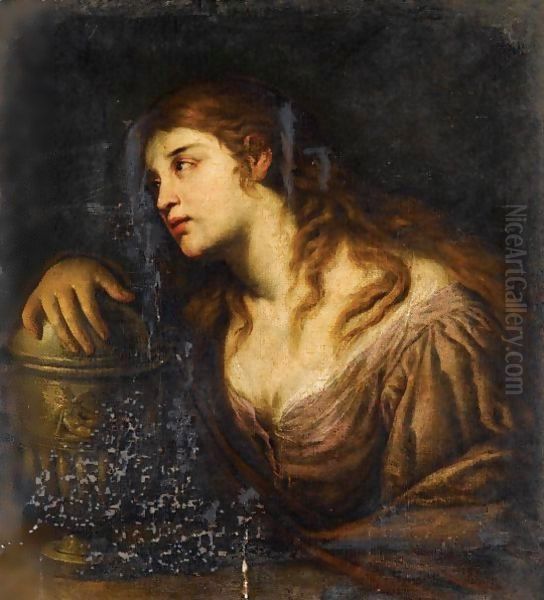
Beyond these, Vaccaro explored a range of biblical narratives. Susanna and the Elders, a subject that combined moral instruction with the potential for dramatic tension and the depiction of the female nude, was another theme he tackled. His ability to render expressive faces and gestures brought these sacred stories to life, making them accessible and emotionally resonant for the contemporary viewer. While religious themes dominated, he also occasionally painted mythological subjects, though these form a smaller part of his known output.
Patronage, Workshop, and the Art Market
Andrea Vaccaro achieved considerable success during his lifetime, becoming one of the most sought-after painters in Naples. He ran a well-organized and productive workshop to meet the high demand for his work. This workshop would have employed assistants and pupils who helped with larger commissions and produced copies or variations of his most popular compositions.
His patrons included Neapolitan churches, religious confraternities, and private collectors. Naples was then under Spanish rule, and Vaccaro's reputation extended to Spain. He received numerous commissions from Spanish patrons, and many of his works were exported to Spain, where they were highly prized by religious orders and aristocratic collectors. This connection with the Spanish market was crucial for many Neapolitan artists of the period, including Jusepe de Ribera.
Prominent collectors and art dealers in Naples, such as Gaspar Roomer and Jan Vanden Eyne, Flemish merchants who played a significant role in the Neapolitan art market, also commissioned and traded works by Vaccaro. His ability to adapt his style, moving from a stricter Caravaggism to a more eclectic and refined manner, broadened his appeal and ensured his continued success in a competitive artistic environment. The demand for his paintings, particularly those featuring half-length figures of saints or Madonnas, was substantial, leading to many workshop repetitions, which sometimes makes definitive attribution of all works bearing his name complex for art historians today.
Notable Works: A Closer Look
While a comprehensive list of Vaccaro's extensive output is beyond the scope of this overview, several key works highlight his artistic strengths and stylistic development:
_David with the Head of Goliath_ (Florence, Fondazione Longhi): An early work, this painting showcases Vaccaro's mastery of Caravaggesque tenebrism. The young David, illuminated against a dark background, holds the severed head of the giant. The psychological intensity of David's expression and the stark realism of Goliath's head are characteristic of this phase.
_Saint Sebastian_ (Naples, Museo di Capodimonte): Another powerful early piece, this depiction of the martyred saint combines physical suffering with spiritual ecstasy. The play of light on Sebastian's body emphasizes his musculature and vulnerability, while his upward gaze suggests his unwavering faith.
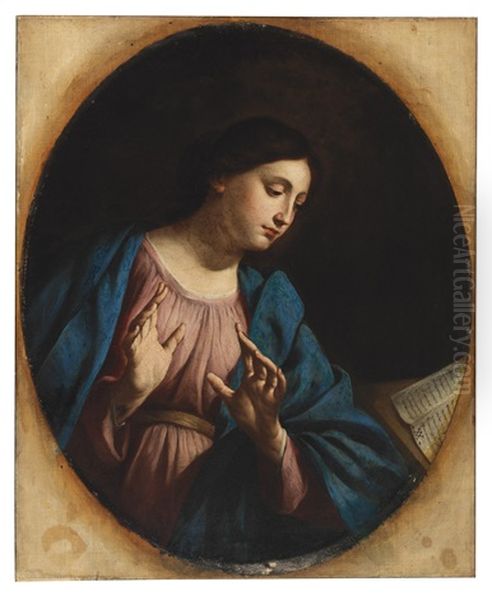
_The Flagellation of Christ_ (copy after Caravaggio, Naples, San Domenico Maggiore): As mentioned, this early copy is crucial for understanding Vaccaro's initial immersion in Caravaggio's style and his technical proficiency in replicating its dramatic effects.
_Saint Rosalia_ (Madrid, Prado Museum): This work likely dates from a more mature phase, showing a softening of the Caravaggesque drama. Saint Rosalia, the patron saint of Palermo, is depicted with a refined grace, and the lighting is more diffused, reflecting the influence of artists like Reni or Van Dyck.
_The Penitent Magdalene_ (various versions): Vaccaro painted this subject multiple times. These works typically show Mary Magdalene in a moment of spiritual contemplation, often with attributes like a skull and a crucifix. They demonstrate his ability to convey deep emotion and sensuous beauty simultaneously, a hallmark of Baroque sensibility.
_Saint John the Baptist_ (Naples, San Domenico Maggiore): This work, likely from his mature period, would exhibit his developed style, balancing naturalistic detail with a certain classical composure, and a sophisticated handling of light and shadow to model the figure and create atmosphere.
_Abraham and the Angels_ (Private Collection): Such narrative scenes allowed Vaccaro to manage multiple figures and create a dynamic composition, showcasing his storytelling abilities and his evolving style that incorporated more complex interactions and a broader range of emotional expression.
These examples illustrate the trajectory of Vaccaro's art, from the dramatic intensity of his early Caravaggesque works to the more balanced and refined classicism of his mature period.
Artistic Relationships and Rivalries
Andrea Vaccaro operated within a dense network of artistic relationships in Naples. His initial engagement with the legacy of Caravaggio placed him in the company of the first generation of Neapolitan Caravaggisti, such as Battistello Caracciolo and Carlo Sellitto. He would have also been aware of the powerful, often starkly realistic, works of Jusepe de Ribera, a dominant figure in Neapolitan art for much of the first half of the 17th century.
As his style evolved, he engaged with the classicizing tendencies of artists influenced by the Bolognese school. Massimo Stanzione, another leading Neapolitan painter, similarly navigated between Caravaggism and a more classical, Reni-influenced style, and there are stylistic affinities between Stanzione and Vaccaro. Bernardo Cavallino, a contemporary, developed a distinctive, lyrical style characterized by delicate figures and a refined palette, representing another facet of Neapolitan Baroque that moved beyond strict Caravaggism.
Vaccaro was also a contemporary of Artemisia Gentileschi during her long Neapolitan period (from 1630). While their styles differed, they were both significant figures contributing to the city's artistic vibrancy.
Later in his career, Vaccaro would have witnessed the rise of a new generation of artists, most notably Luca Giordano. Known for his astonishing speed and versatility, Giordano would come to dominate Neapolitan painting in the latter half of the 17th century. An anecdote recounts a competition for a commission to design a "Madonna" for the church of Santa Maria del Pianto, in which Vaccaro reportedly defeated the younger Giordano. This story, whether entirely accurate or not, highlights Vaccaro's established reputation even as new talents emerged. His son, Nicola Vaccaro, also became a painter, continuing the family's artistic legacy, though he did not achieve the same level of fame as his father.
Later Career, Reputation, and Legacy
Andrea Vaccaro remained a highly respected and productive artist throughout his career, maintaining his prominent position in the Neapolitan art scene until his death in 1670. His ability to synthesize various influences into a coherent and appealing style ensured his enduring popularity. He was considered one of the leading painters of the Neapolitan school, particularly praised for the grace and piety of his figures.
His reputation extended beyond Naples, especially to Spain, where his works were eagerly collected and influenced local artists. Many of his paintings are still found in Spanish churches and museums, a testament to this strong connection.
In art historical assessments, Vaccaro is recognized as a key figure in the transition of Neapolitan painting from the dramatic naturalism of early Caravaggism to a more classical and refined Baroque style. While perhaps not as revolutionary as Caravaggio or as dazzlingly virtuosic as Luca Giordano, Vaccaro's contribution was significant. He created a body of work characterized by its consistent quality, emotional sincerity, and sophisticated understanding of composition and color.
Some art historical discussions might touch upon the "evenness" of his output, which, while ensuring a high standard, sometimes led to a perception of him being less daring than some of his contemporaries. There have also been debates regarding attributions, given the productivity of his workshop and the number of copies and variations of his popular compositions. However, his best works undoubtedly demonstrate a masterful command of his art.
Art Historical Evaluation and Controversies
In the broader narrative of art history, Andrea Vaccaro is firmly placed as a leading exponent of the Neapolitan Baroque. His artistic journey reflects the dynamic interplay of influences that characterized this period in Naples. He successfully navigated the powerful legacy of Caravaggio, absorbing its lessons in naturalism and dramatic lighting, while also embracing the elegance and classicism promoted by artists like Guido Reni and the refined aesthetics of Van Dyck.
The primary "controversy," if it can be termed as such, often revolves around the consistency and, for some critics, the perceived lack of bold innovation in his later works compared to the more visceral impact of his early Caravaggesque phase. Some scholars have noted that in striving for a balance between Reni's classicism and Caravaggio's naturalism, his work sometimes achieved a pleasing harmony but occasionally at the expense of the raw emotional power seen in artists who adhered more strictly to one stylistic camp.
Attribution issues also persist, a common challenge with prolific artists who maintained large workshops. Distinguishing between autograph works, workshop productions, and copies by followers can be complex. This is not a criticism of Vaccaro himself but a reflection of 17th-century workshop practices and the high demand for his art.
Despite these academic discussions, Vaccaro's historical importance is undeniable. He was a highly successful artist in his own time, fulfilling major commissions and influencing a generation of painters. His ability to create deeply pious and emotionally resonant religious imagery met the spiritual needs of the Counter-Reformation era. His works remain a significant presence in Neapolitan churches and international museum collections, offering a testament to his skill and enduring appeal. He was, until the full emergence of Luca Giordano, widely considered one of the most distinguished painters in Naples.
Conclusion: An Enduring Neapolitan Voice
Andrea Vaccaro was a pivotal figure in the rich tapestry of Neapolitan Baroque art. His career exemplifies the artistic dynamism of 17th-century Naples, a city that was a melting pot of Italian and international influences. Starting from a strong grounding in Caravaggism, he skillfully integrated elements of Bolognese classicism and Flemish elegance to create a personal style that was both dignified and deeply human. His religious paintings, characterized by their emotional sincerity, refined execution, and masterful use of light, resonated profoundly with his contemporaries and continue to be appreciated for their quiet power and devotional intensity. While navigating the complex artistic currents of his time, Vaccaro carved out a distinct and respected place for himself, leaving behind a substantial body of work that enriches our understanding of one of the most vibrant periods in Italian art history. His legacy is that of a consummate professional, a master craftsman, and a sensitive interpreter of sacred narratives.